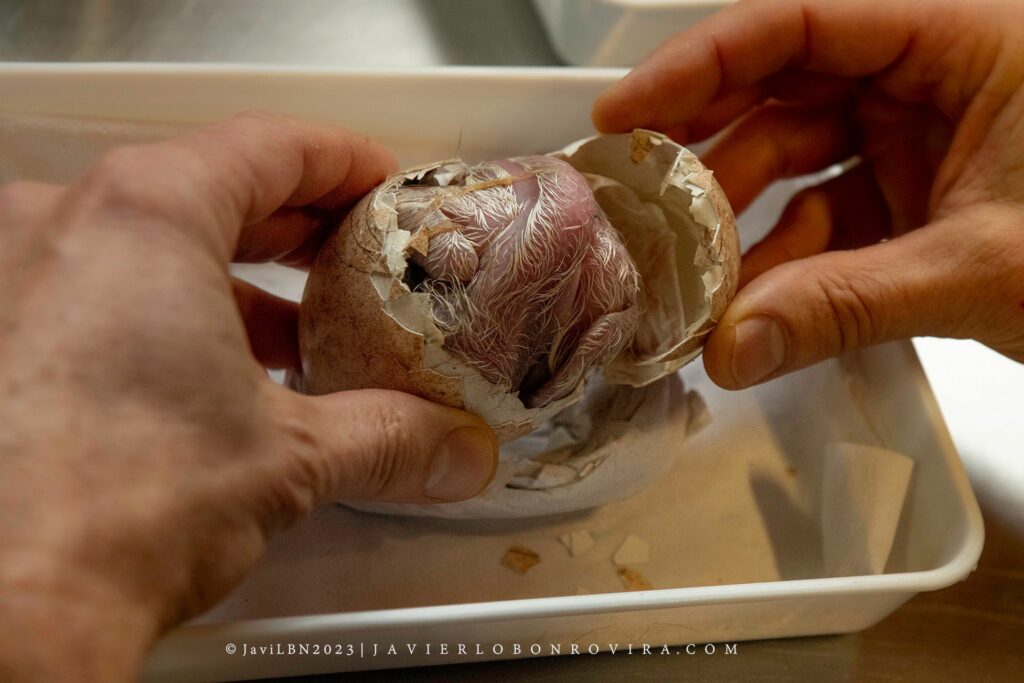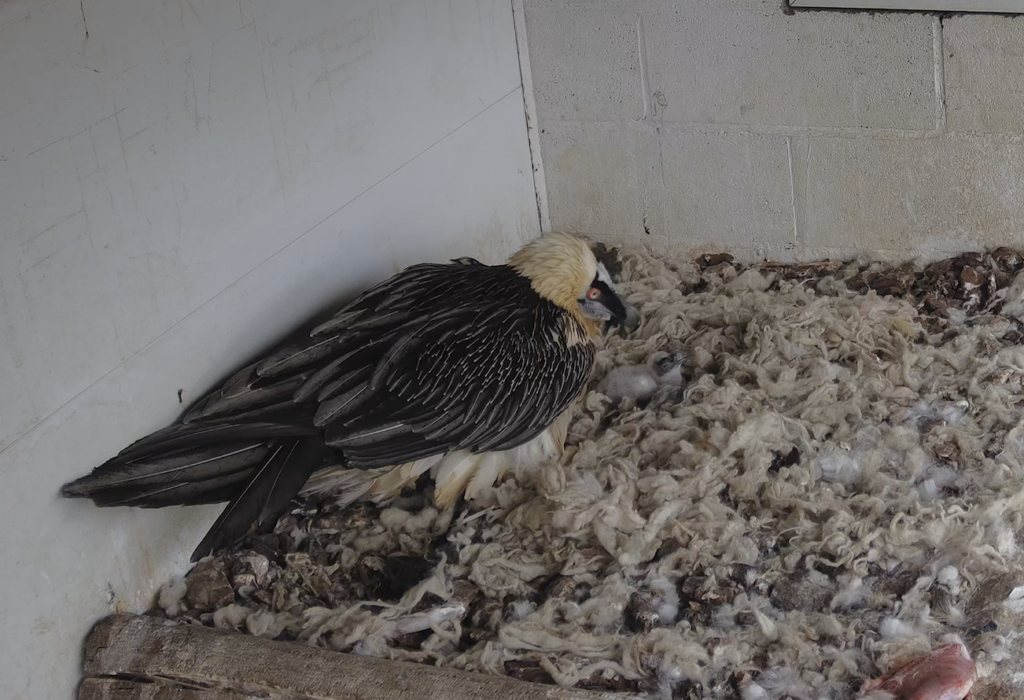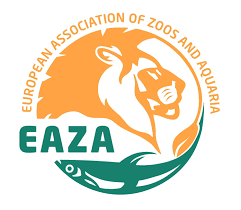
The wait is over – after weeks of anticipation, the first chick of the season has finally hatched at our Specialised Bearded Vulture Breeding Unit located within Vallcalent’s wildlife centre. On that fateful morning of Thursday, 16 February 2023, the hatching of BG-1165 marked an important moment as it is the first offspring of the legendary Aïnat, one of the founder birds of the Bearded Vulture Captive Breeding Network (Bearded Vulture EEP). The chick is also the only descendant of Sombra, who unfortunately passed away a few weeks ago. Thankfully, BG-1165 is a strong and healthy chick that shows a great appetite and a strong voice, certainly making its presence known.


The descent of Aïnat, one of the founders of the Bearded Vultures EEP
The breeding season for Bearded Vultures starts in autumn, unlike many European species, which wait until spring to breed. This season was no exception, with Aïnat and Sombra copulating in the last days of October 2022.
Aïnat, the father, was rescued from a Pyrenean nest back in 2008 through a programme to save second chicks from wild nests. Although Bearded Vultures can lay two eggs every season, only one survives, as the older chicks have an innate behaviour of attacking their younger siblings. Known as cainism, this evolutionary behaviour is observed in other raptor species when there are food shortages, but among Bearded Vultures, it seems to be an instinctive condition, even when there is enough food for both. In the wild, the weakest chick either dies of injuries or starvation.
Adopted and raised in our Specialised Unit within Vallcalent, Aïnat was first paired with the female Greca when they were both juveniles. Despite many attempts to mate over several seasons, Greca has always rejected Aïnat, and he started mating with perches close to the female. A possible sign of frustration is observed in other males too, after so many years of being unable to mate. The pair were finally separated and in 2020, Aïnat was paired with Sombra.
Sombra, an imprinted female from Kazakhstan
Sombra was hand reared in 2002 in the Zoo of Almaty, Kazakhstan. Before arriving at Vallcalent, the female passed through different private breeding centres, and, unfortunately, there is not much background information about her.
Imprinted females can be paired with Bearded Vulture males, but very often they show behavioural problems to breed and can be very aggressive with their keepers. The pairing with Aïnat was difficult: at the beginning he attacked her and after they were moved to a different aviary, she attacked him instead. As time passed, she started to tolerate his presence but always showed dominant behaviour. Finally, they started to show signs of pairing and started allopreening (cleaning each other’s feathers) and nest building.
A difficult but successful pairing
When the mating time arrived, however, Aïnat mated with perches again, even though Sombra was indicating her willingness to mate by lifting her tail. Our team at Vallcalent had to be very creative to sort out the situation: they installed logs on the top of perches, hoping the female would use them (as dominant birds often tend to climb to the highest points) and convince the male that she was ready to mate. Finally, on January 2022, the male regained his confidence, and they successfully mated and eventually laid eggs. However, both eggs were infertile as probably it was too late in the season.
This season, however, Aïnat and Sombra were able to lay two eggs earlier: the first clutch was out on 18 December 2022, followed by a second one on the 25th. The team at Vallcalent removed them both to artificially incubate them and replaced them with dummy eggs, as Sombra was showing signs of being sick and was not incubating regularly. Although both eggs seemed fertile, one had a crack (that was sealed) but aborted a few days after hatching. Sadly, Sombra died five days later, which marked a significant loss for Vallcalent.
From a new brooder to his foster father

BG-1165 hatched on Thursday, 16 February 2023, healthy and with a great appetite. Thanks to a new brooder donated by the Barcelona Zoo Foundation, the chick spent a very comfortable first week. As per protocol, captive-bred chicks are hand-reared for the first 4-5 days until they are strong enough to maintain their heads up and better tolerate low temperatures when the adoption by the foster parent takes place. Before a week had passed, BG-1165 needed to be moved with Bearded Vultures to prevent human imprinting and ensure that the chick behaves like a wild bird when it grows up. This will allow it to breed and survive in the wild.
On 23 February, Kajazo, a human-imprinted Bearded Vulture male, successfully adopted BG-1165. Kajazo is a special case because he ‘pairs’ with Alex Llopis, our Captive Breeding Manager. Alex had spent at least one hour a day with Kajazo since autumn, imitating the species’ breeding behaviour, like preening and incubating, to ensure Kajazo remained in the breeding mood. Just like in previous years, this enables the male vulture to eventually adopt and rear a chick when the time comes, making Kajazo an ideal foster father for BG-1165.


Captive breeding plays a fundamental role in the conservation of Bearded Vultures in Europe
The Bearded Vulture Captive Breeding Network, managed by the Vulture Conservation Foundation (VCF) on behalf of EAZA’s European Endangered Species Programme, consists of a network of zoos, private collections and specialised breeding centres that breed Bearded Vultures in captivity for conservation purposes.
We are managing the Bearded Vulture Specialised Breeding Uni thanks to an agreement between the VCF and Generalitat de Catalonia, who own the Centre de Fauna Vallcalent. Over the last decades, our team in the centre has specialised in artificial incubation and has long experience dealing with pairs having a difficult time reproducing. The breeding period runs from autumn until summer. The chicks successfully reared are either released in the wild to support reintroduction or restocking programmes or kept in captivity, distributed within the Bearded Vulture EEP’s facilities, to ensure genetic diversity and the sustainability of the captive breeding programme in the long run.
We would like to express our gratitude to the Barcelona Zoo Foundation, supporting us since 2014, for the new brooder offered to Vallcalent. It will certainly help us incubate and rear the upcoming chicks, as it was already of great help with BG-1165.








